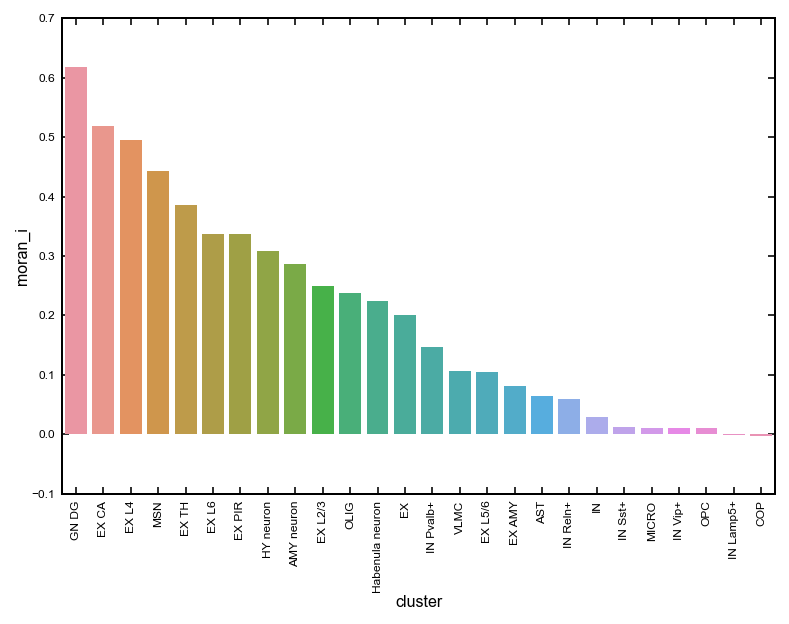Note
This page was generated from
3_combined_analysis.ipynb.
Interactive online version:
.
Some tutorial content may look better in light mode.
3.Basic spatial domain-cell analysis#
This notebook implements the basic domain-cell analysis in spateo paper:
Cell-Domain specificity and heterogeneity analysis (i.e. cell composition in each domain & cell distribution among domains)
Celltype co-localization analysis (based on spatial nearest neighbors)
Packages#
[1]:
import numpy as np
import pandas as pd
import spateo as st
import dynamo as dyn
import matplotlib.pyplot as plt
import seaborn as sns
from scipy.sparse import isspmatrix
to_dense_matrix = lambda X: np.array(X.todense()) if isspmatrix(X) else np.asarray(X)
st.configuration.set_pub_style_mpltex()
%matplotlib inline
2022-11-11 00:56:20.352725: I tensorflow/core/util/util.cc:169] oneDNN custom operations are on. You may see slightly different numerical results due to floating-point round-off errors from different computation orders. To turn them off, set the environment variable `TF_ENABLE_ONEDNN_OPTS=0`.
network.py (36): The next major release of pysal/spaghetti (2.0.0) will drop support for all ``libpysal.cg`` geometries. This change is a first step in refactoring ``spaghetti`` that is expected to result in dramatically reduced runtimes for network instantiation and operations. Users currently requiring network and point pattern input as ``libpysal.cg`` geometries should prepare for this simply by converting to ``shapely`` geometries.
|-----> setting visualization default mode in dynamo. Your customized matplotlib settings might be overritten.
Data source#
bin60_clustered_h5ad: https://www.dropbox.com/s/wxgkim87uhpaz1c/mousebrain_bin60_clustered.h5ad?dl=0
cellbin_clustered_h5ad: https://www.dropbox.com/s/seusnva0dgg5de5/mousebrain_cellbin_clustered.h5ad?dl=0
[2]:
# Load annotated binning data
fname_bin60 = "mousebrain_bin60_clustered.h5ad"
adata_bin60 = st.sample_data.mousebrain(fname_bin60)
# Load annotated cellbin data
fname_cellbin = "mousebrain_cellbin_clustered.h5ad"
adata_cellbin = st.sample_data.mousebrain(fname_cellbin)
adata_bin60, adata_cellbin
[2]:
(AnnData object with n_obs × n_vars = 7765 × 21667
obs: 'area', 'n_counts', 'Size_Factor', 'initial_cell_size', 'louvain', 'scc', 'scc_anno'
var: 'pass_basic_filter'
uns: '__type', 'louvain', 'louvain_colors', 'neighbors', 'pp', 'scc', 'scc_anno_colors', 'scc_colors', 'spatial', 'spatial_neighbors'
obsm: 'X_pca', 'X_spatial', 'bbox', 'contour', 'spatial'
layers: 'count', 'spliced', 'unspliced'
obsp: 'connectivities', 'distances', 'spatial_connectivities', 'spatial_distances',
AnnData object with n_obs × n_vars = 11854 × 14645
obs: 'area', 'pass_basic_filter', 'n_counts', 'louvain', 'Celltype'
var: 'mt', 'pass_basic_filter'
uns: 'Celltype_colors', '__type', 'louvain', 'neighbors', 'spatial'
obsm: 'X_pca', 'X_spatial', 'bbox', 'contour', 'spatial'
layers: 'count', 'spliced', 'unspliced'
obsp: 'connectivities', 'distances')
Transfer domain annotation to cells#
[ ]:
# Extract spatial domains from SCC clusters.
# Transfer domain annotation to cells.
st.dd.set_domains(
adata_high_res=adata_cellbin,
adata_low_res=adata_bin60,
bin_size_high=1,
bin_size_low=60,
cluster_key="scc_anno",
domain_key_prefix="transfered_domain",
k_size=1.8,
min_area=16,
)
[4]:
# View cell domain
st.pl.space(
adata_cellbin,
color=['transfered_domain_scc_anno'],
pointsize=0.1,
show_legend="upper left",
figsize=(4, 3),
color_key_cmap = "tab20",
)
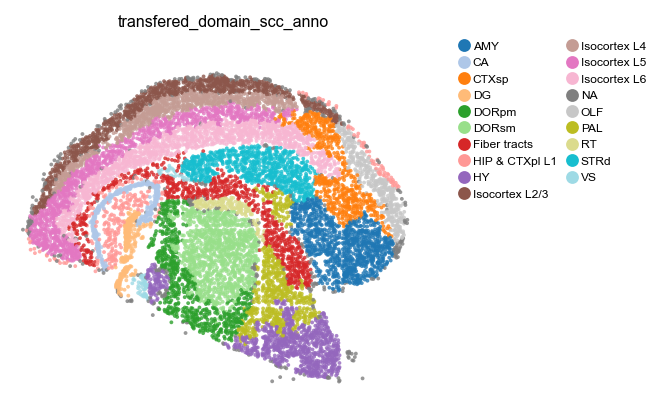
Cell-Domain specificity and heterogeneity#
[5]:
# Summary domain-cell relationship
domain_list = np.array([])
celltype_list = np.array([])
count_list = np.array([])
for i in np.unique(adata_cellbin.obs['transfered_domain_scc_anno']):
tmp, counts = np.unique(adata_cellbin[adata_cellbin.obs['transfered_domain_scc_anno'] == i,:].obs['Celltype'], return_counts=True)
domain_list = np.append(domain_list, np.repeat(i, len(counts)))
celltype_list = np.append(celltype_list, tmp)
count_list = np.append(count_list, counts)
hetero_df = pd.DataFrame({"domain":domain_list, "celltype":celltype_list, "count":count_list.astype(int)})
hetero_df[0:10]
[5]:
| domain | celltype | count | |
|---|---|---|---|
| 0 | AMY | AMY neuron | 418 |
| 1 | AMY | AST | 98 |
| 2 | AMY | COP | 1 |
| 3 | AMY | EX | 70 |
| 4 | AMY | EX AMY | 4 |
| 5 | AMY | EX CA | 1 |
| 6 | AMY | EX L5/6 | 4 |
| 7 | AMY | EX PIR | 8 |
| 8 | AMY | HY neuron | 182 |
| 9 | AMY | Habenula neuron | 1 |
[6]:
# Cell distribution among domains
spec_df_plt = hetero_df.pivot(index="celltype", columns="domain", values="count").fillna(0)
spec_df_plt = spec_df_plt.div(spec_df_plt.sum(axis=1), axis=0)
spec_df_plt['Celltype'] = spec_df_plt.index
spec_df_plt.index = pd.CategoricalIndex(spec_df_plt.index, categories=spec_df_plt.index.astype(str).sort_values())
spec_df_plt = spec_df_plt.sort_index(ascending=False)
spec_df_plt.plot(
x = 'Celltype',
kind = 'barh',
stacked = True,
title = 'Stacked Bar Graph',
mark_right = True,
figsize=(4, 4),
legend = False,
)
[6]:
<AxesSubplot:title={'center':'Stacked Bar Graph'}, ylabel='Celltype'>
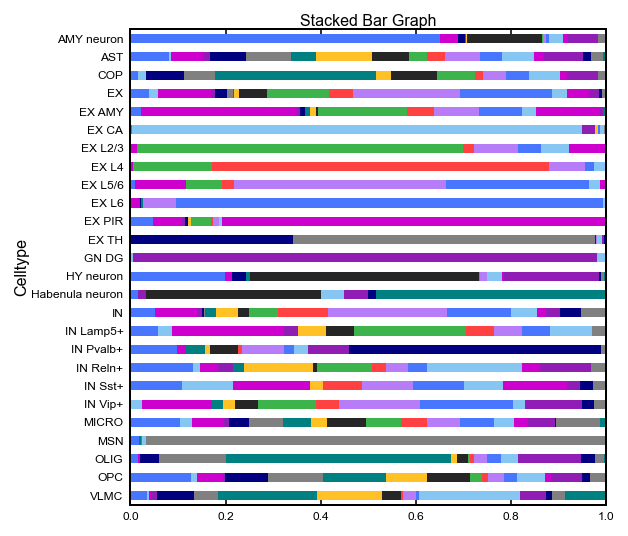
[7]:
# Cell composition within each domain
hetero_df_plt = hetero_df[hetero_df.domain!="NA"].pivot(index="domain", columns="celltype", values="count").fillna(0)
hetero_df_plt = hetero_df_plt.div(hetero_df_plt.sum(axis=1), axis=0)
sns.heatmap(hetero_df_plt.T)
[7]:
<AxesSubplot:xlabel='domain', ylabel='celltype'>
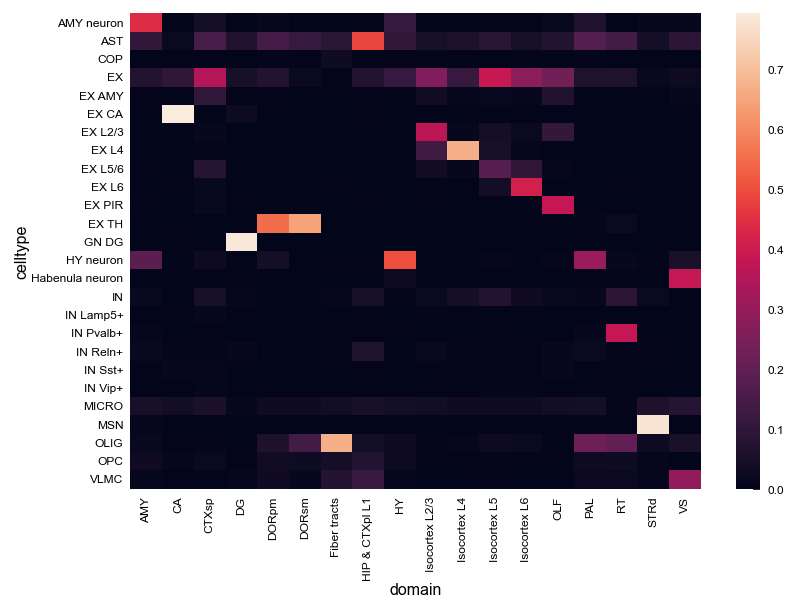
Celltype spatial distribution#
[ ]:
# Celltype co-localization (OPC and others)
# Doing dyn.tl.neighbors for N times is easy but time comsuming. (One time is enough, to be optimized soon)
# Should hide the logging of this codeblock (neighbor finding outputs too much log)
celltype_of_interest = "OPC"
n_neigh = []
neigh_type = []
neigh_cnt = []
for i in range(0,100):
dyn.tl.neighbors(
adata_cellbin,
X_data=adata_cellbin.obsm['spatial'],
n_neighbors=i+2,
result_prefix="spatial",
n_pca_components=30, # doesn't matter
)
sp_con = adata_cellbin.obsp['spatial_connectivities'][adata_cellbin.obs['Celltype']==celltype_of_interest, :].copy()
sp_con.data[sp_con.data > 0] = 1
sp_con = to_dense_matrix(sp_con)
for k in range(sp_con.shape[0]):
for j in np.unique(adata_cellbin.obs['Celltype']):
n_neigh.append(i)
neigh_type.append(j)
neigh_cnt.append(sum(sp_con[k,adata_cellbin.obs['Celltype'] == j]) / sum(sp_con[k,:]))
df_plt = pd.DataFrame({"Neighbors":n_neigh, "Celltype":neigh_type, "Percentage":neigh_cnt})
[9]:
# Celltype co-localization (OPC and others)
# Lineplot in spateo paper
fig = plt.figure(figsize=(3, 3))
sns.lineplot(data=df_plt, x='Neighbors', y='Percentage', hue='Celltype',ci=90, err_kws={"alpha": 0.1})
plt.legend(bbox_to_anchor=(1.05, 1), loc=2, borderaxespad=0.)
[9]:
<matplotlib.legend.Legend at 0x7f867698f730>
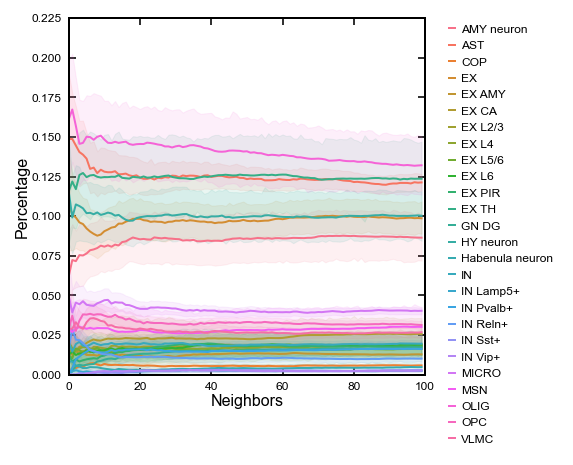
[ ]:
# Calculate Moran's I score for celltypes
moran_df = st.tl.cellbin_morani(adata_cellbin, binsize=50)
fig = sns.barplot(x='cluster',y='moran_i',data=moran_df)
_ = plt.xticks(rotation=90)
|-----> Calculating cell counts in each bin, using binsize 50
|-----> Calculating Moran's I score for each celltype
